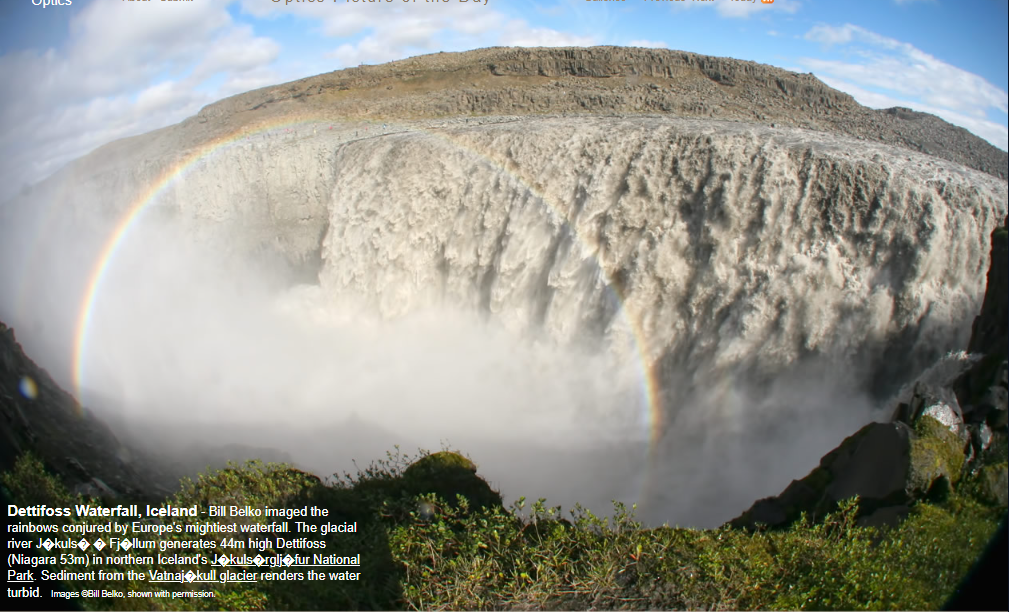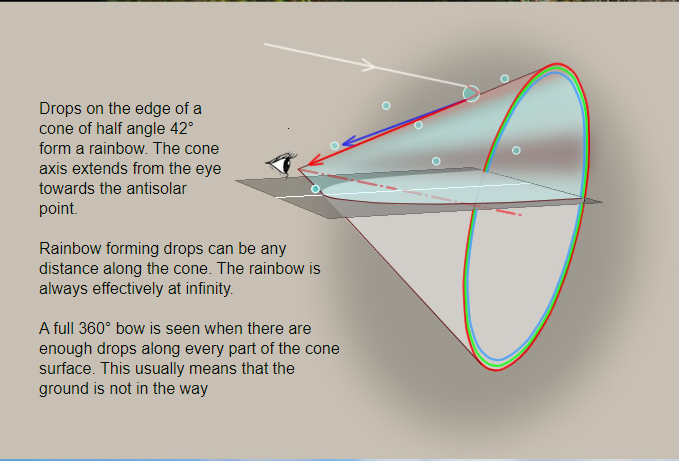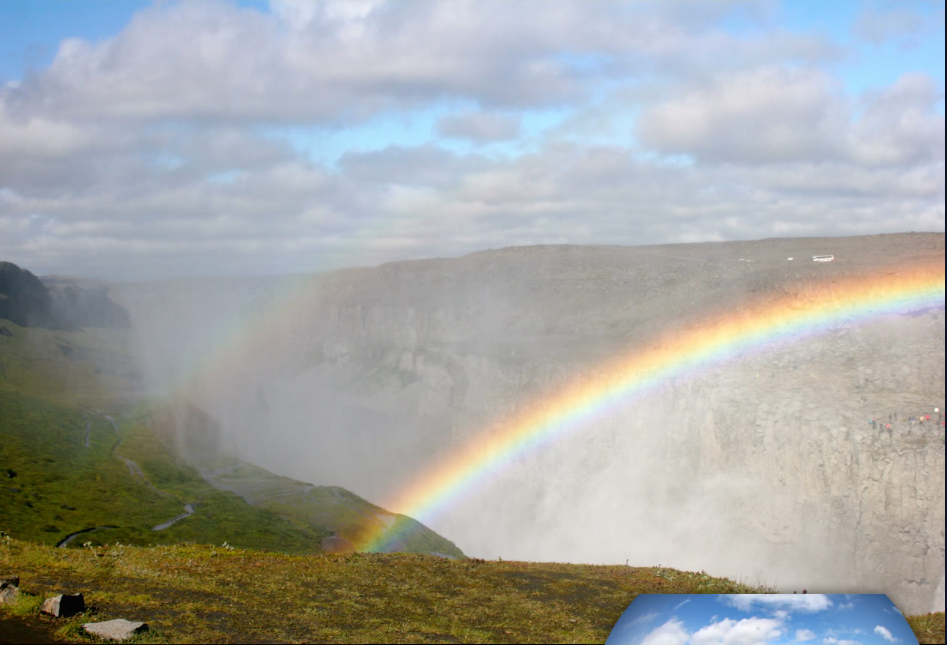OPOD - Dettifoss, Iceland Rainbow
OPOD - Dettifoss, Iceland Rainbow: A Captivating Natural Phenomenon
Dettifoss Waterfall in Iceland is renowned for its awe-inspiring beauty, and it is also known to create mesmerizing rainbows. Located in Jökulsárgljúfur National Park, this powerful waterfall is formed by the glacial river Jökulsá á Fjöllum, which originates from the Vatnajökull glacier. With a height of 44 meters (Niagara Falls is 53 meters), Dettifoss is Europe's mightiest waterfall. The sediment carried by the glacial river gives the water a turbid appearance, adding to the enchantment of the scene.
When drops of water on the edge of a cone with a half angle of 42° are present, a rainbow forms. This cone extends from the observer's eye towards the antisolar point, which is the point directly opposite the Sun. It is important to note that the drops forming the rainbow can be located at any distance along the cone, but the rainbow always appears effectively at infinity.
To observe a complete 360° rainbow, there must be enough water droplets distributed along every part of the cone's surface. In such cases, the ground does not obstruct the view. The circular shape of the rainbow is consistent regardless of its size. In the case of Dettifoss, photographer Bill Belko captured an impressive 84° diameter rainbow using a Canon EOS 20D camera with a Sigma circular fisheye lens.
Bill's panoramic image reveals an interesting phenomenon known as Alexander's Dark Band. This band appears between the primary and secondary bows of the rainbow. It is a region where water droplets cannot deflect light except for a minuscule amount that is directly reflected from their outer surface. The primary bow's colors may appear slightly desaturated due to the smaller size of the spray and mist droplets from the waterfall compared to raindrops.
As the size of the water droplets decreases, bows become broader and exhibit more pastel colors. This is because diffraction causes the light to scatter more, resulting in a diffuse appearance. Eventually, the bow may transform into a fog or cloudbow. The slight distortion seen in the image of the rainbow at Dettifoss is due to the wide lens used by Bill Belko.
The captivating beauty of the rainbow at Dettifoss Waterfall is a testament to the intricate interplay between light, water droplets, and atmospheric conditions. Each element contributes to the formation and appearance of this natural wonder. As visitors stand in awe of the magnificent waterfall, they are also treated to the ethereal spectacle of a rainbow stretching across the sky, adding a touch of magic to an already extraordinary landscape.
In conclusion, Dettifoss Waterfall in Iceland offers a remarkable display of rainbows that captivate the imagination. With its glacial origins, turbid waters, and powerful flow, this natural wonder creates an enchanting backdrop for observing atmospheric optics phenomena. From the circular shape of the rainbow to the presence of Alexander's Dark Band, there is much to discover and appreciate about the interplay between light and water droplets at this majestic location. The Dettifoss rainbow serves as a reminder of the beauty and complexity of our natural world, inspiring awe and wonder in all who have the privilege to witness it.

Dettifoss Waterfall, Iceland - Bill Belko imaged the rainbows conjured by Europe's mightiest waterfall. The glacial river J�kuls� � Fj�llum generates 44m high Dettifoss (Niagara 53m) in northern Iceland's J�kuls�rglj�fur National Park. Sediment from the Vatnaj�kull glacier renders the water turbid. Images ©Bill Belko, shown with permission.

Drops on the edge of a cone of half angle 42° form a rainbow. The cone axis extends from the eye towards the antisolar point.
Rainbow forming drops can be any distance along the cone. The rainbow is always effectively at infinity.
A full 360° bow is seen when there are enough drops along every part of the cone surface. This usually means that the ground is not in the way
Dettifoss
Bill's shadow is at the bow's centre. He captured the panorama with a Canon EOS 20D with a Sigma circular fish eye 180deg 8mm 1:4EX. The 84° diameter rainbow is always circular and the slight distortion in the image arises from the necessarily wide lens.
Lower image: Shows Alexander's Dark Band between the primary and secondary bows. Water drops cannot deflect light into this region except for a miniscule amount reflected directly from their outer surface.
The primary bow colours are slightly desaturated. Spray and mist droplets from the falls are smaller than raindrops. Bows get broader and more pastel coloured as the drop size decreases. Diffraction makes them increasingly diffuse until eventually we see a fog or cloudbow.


Note: this article has been automatically converted from the old site and may not appear as intended. You can find the original article here.
Reference Atmospheric Optics
If you use any of the definitions, information, or data presented on Atmospheric Optics, please copy the link or reference below to properly credit us as the reference source. Thank you!
-
<a href="https://atoptics.co.uk/blog/opod-dettifoss-iceland-rainbow/">OPOD - Dettifoss, Iceland Rainbow</a>
-
"OPOD - Dettifoss, Iceland Rainbow". Atmospheric Optics. Accessed on November 26, 2024. https://atoptics.co.uk/blog/opod-dettifoss-iceland-rainbow/.
-
"OPOD - Dettifoss, Iceland Rainbow". Atmospheric Optics, https://atoptics.co.uk/blog/opod-dettifoss-iceland-rainbow/. Accessed 26 November, 2024
-
OPOD - Dettifoss, Iceland Rainbow. Atmospheric Optics. Retrieved from https://atoptics.co.uk/blog/opod-dettifoss-iceland-rainbow/.